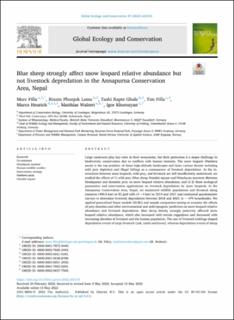| dc.contributor.author | Filla, Marc | |
| dc.contributor.author | Lama, Rinzin Phunjok | |
| dc.contributor.author | Ghale, Tashi Rapte | |
| dc.contributor.author | Filla, Tim | |
| dc.contributor.author | Heurich, Marco Dietmar | |
| dc.contributor.author | Waltert, Matthias | |
| dc.contributor.author | Khorozyan, Igor | |
| dc.date.accessioned | 2022-09-14T10:46:27Z | |
| dc.date.available | 2022-09-14T10:46:27Z | |
| dc.date.created | 2022-09-04T21:17:19Z | |
| dc.date.issued | 2022 | |
| dc.identifier.citation | Global Ecology and Conservation. 2022, 37 | en_US |
| dc.identifier.issn | 2351-9894 | |
| dc.identifier.uri | https://hdl.handle.net/11250/3017776 | |
| dc.description.abstract | Large carnivores play key roles in their ecosystems, but their protection is a major challenge in biodiversity conservation due to conflicts with human interests. The snow leopard (Panthera uncia) is the top predator of Asian high-altitude landscapes and faces various threats including wild prey depletion and illegal killings as a consequence of livestock depredation. As the interactions between snow leopards, wild prey, and livestock are still insufficiently understood, we studied the effects of 1) wild prey (blue sheep Pseudois nayaur and Himalayan marmots Marmota himalayana) and domestic prey on snow leopard relative abundance, and of 2) these ecological parameters and intervention applications on livestock depredation by snow leopards. In the Annapurna Conservation Area, Nepal, we monitored wildlife populations and livestock along transects (490.8 km) in 82 grid cells (4 ×4 km) in 2019 and 2021 and conducted questionnaire surveys to determine livestock depredation between 2018 and 2021 (n = 479 households). We applied generalized linear models (GLMs) and sample comparison testing to examine the effects of prey densities and other environmental and anthropogenic predictors on snow leopard relative abundance and livestock depredation. Blue sheep density strongly positively affected snow leopard relative abundance, which also increased with terrain ruggedness and decreased with increasing densities of livestock and the human population. The size of livestock holdings shaped depredation events of large livestock (yak, cattle and horse), whereas depredation events of sheep and goats, which accounted for most (68.6%) depredated animals, decreased with increasing human population density and marmot presence. The strong impact of blue sheep on snow leopard relative abundance supports demands for integrating this ungulate into conservation and management plans, including wild prey recovery and translocation. The rather weak evidence for effects of blue sheep on depredation events suggests that conflicts over livestock depredation by snow leopards would neither be inflicted nor solved by increasing wild prey abundance. This demonstrates the need to improve intervention strategies in the Annapurna region, such as predator-proofing corrals and optimizing daytime herding practices. We suggest further exploring the effects of marmots and other secondary prey on livestock depredation rates, and testing the suitability of additional interventions, e.g., dogs and deterrents, as conflict mitigation tools. Our results will support wildlife managers in setting conservation priorities to promote the long-term co-existence of local people and snow leopards. | en_US |
| dc.language.iso | eng | en_US |
| dc.rights | Attribution-NonCommercial-NoDerivatives 4.0 Internasjonal | * |
| dc.rights.uri | http://creativecommons.org/licenses/by-nc-nd/4.0/deed.no | * |
| dc.subject | Himalayan marmot | en_US |
| dc.subject | Human-wildlife conflict | en_US |
| dc.subject | intervention strategy | en_US |
| dc.subject | Panthera uncia | en_US |
| dc.subject | Pseudois nayaur | en_US |
| dc.title | Blue sheep strongly affect snow leopard relative abundance but not livestock depredation in the Annapurna Conservation Area, Nepal | en_US |
| dc.title.alternative | Blue sheep strongly affect snow leopard relative abundance but not livestock depredation in the Annapurna Conservation Area, Nepal | en_US |
| dc.type | Peer reviewed | en_US |
| dc.type | Journal article | en_US |
| dc.description.version | publishedVersion | en_US |
| dc.subject.nsi | VDP::Matematikk og Naturvitenskap: 400 | en_US |
| dc.source.pagenumber | 15 | en_US |
| dc.source.volume | 37 | en_US |
| dc.source.journal | Global Ecology and Conservation | en_US |
| dc.identifier.doi | 10.1016/j.gecco.2022.e02153 | |
| dc.identifier.cristin | 2048650 | |
| cristin.ispublished | true | |
| cristin.fulltext | original | |
| cristin.qualitycode | 1 | |

